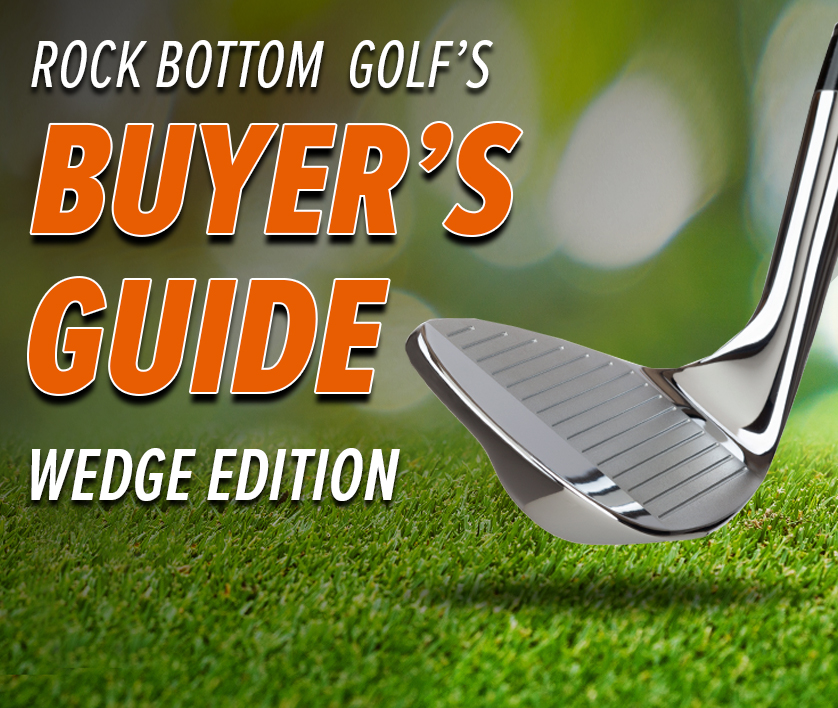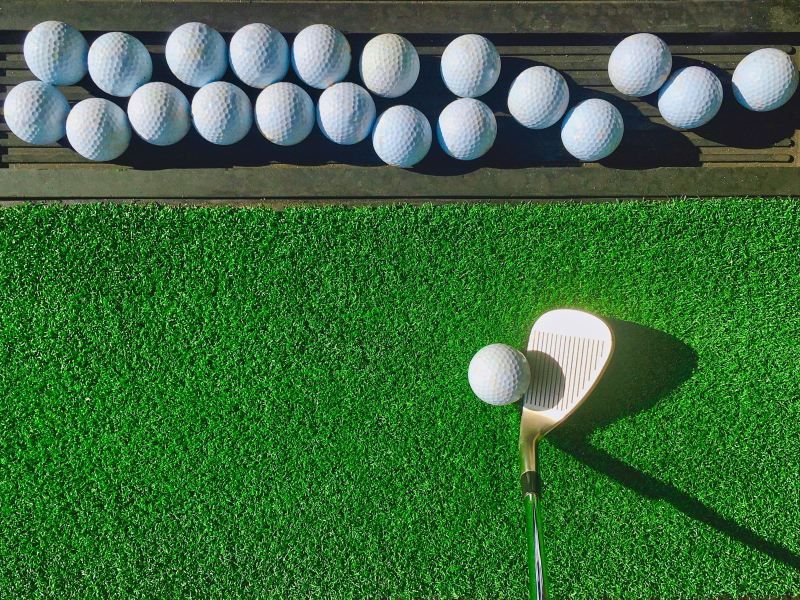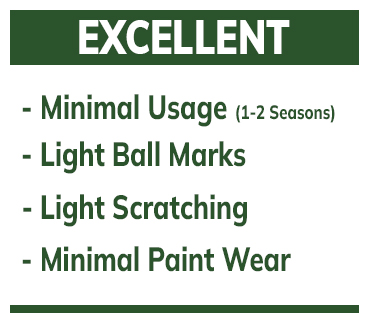

Table Of Contents: Golf Wedge Buyer's Guide
What Golf Wedge Should You Buy
The right equipment on the golf course can be the difference between success and failure. Accordingly, the ability to traverse the terrain and stay under par is essential for success. Navigating bunkers, rough terrain, and difficult shots require a specialized type of club to get you up and over these challenges. A versatile option for most golfers would be a wedge with a loft between 54 to 60 degrees. This range is suitable for a variety of shots, including sand traps and short approaches.
Any experienced golfer knows that wedges are integral to your golf equipment. Here is a breakdown of the various types of wedges, their critical components, and some of the most popular golf wedges made by top golf manufacturers.
Types Of Wedges
There are multiple types of wedges. Each exists to help you overcome terrain challenges on the golf course. Here are the four major categories of wedges:

-
Pitching Wedge
Many consider it the most prolific of the group, and it has the lowest loft of any wedge. A pitching wedge is best used on approach shots outside the green.
-
Gap Wedge
The gap wedge fills the loft gap between a pitching wedge and a sand wedge.
-
Sand Wedge
The aptly named sand wedge stands ready to get you out of some of the most challenging conditions you will face on the course. This wedge is ideal for bunkers or rough terrain.
-
Lob Wedge
The lob wedge is the highest lofted wedge. The loft is perfect when you need to drop the ball onto the green from a lower position in the rough or fairway.
Which Wedges Do Most Golfers Carry?
Naturally, there isn't unlimited space in your golf bag. Many golfers wonder how many wedges you should carry. While there are golfers who take all four wedges, there are many that do not. For example, some golfers don't use the lob wedge during most rounds. And some golfers may only use a pitching wedge and a sand wedge. On the flip side, you may be in the middle of a game and find yourself without the best wedge for the current shot. In that case, you may be at a huge disadvantage when you need a precision angle from a club you do not have.
How Many Wedges Should Your Golf Bag Hold?
The general rule of thumb is to carry three wedges in your golf bag –– a pitching wedge, sand wedge, and lob wedge. However, many professional players will have five or more wedges in their bags to provide the most options possible and increase their chances of success.
That said, many golfers still question –– the number of wedges your golf bag should house. For example, some golfers don't use the lob wedge during most rounds, and some golfers may only use a pitching wedge and a sand wedge. On the contrary, you may be in the middle of a game and find yourself without the best wedge for the current shot, inevitably placing yourself at a considerable disadvantage.
However, you can't predict every outcome in life, in golf or any other sport. So, it's essential to remember that success doesn't come without failure, and sometimes when you find yourself at a disadvantage –– it's in those moments you still find a way to shine!
Juniors, Women, & Handicap Golfers: What Are The Best Wedges?
When choosing the best wedges for juniors, women, and handicap players, the most important factor is –– the skill level each player has. If the player is a beginner or intermediate golfer, choosing a basic wedge that offers adequate control and forgiveness is best. Advanced players may require a higher-level wedge with more features and improved performance.
The shaft flex should also be considered when choosing the best wedges for juniors, women, and handicap golfers. Flexible shafts provide more control and accuracy, while stiffer shafts offer greater distance potential. For beginner golfers, selecting a wedge with less loft may be beneficial, providing more control and precision.

Basic Components When Choosing A Wedge
Like all golf clubs, there are criteria you want to consider when choosing what is best for you. And this involves several factors. Here are some of the most essential things to consider before you select what is going in your golf bag.
Loft
One of the most crucial factors in understanding wedges is the loft. The loft is the angle of the club face. Manipulating the golf club's loft increases the angle or height the ball goes after it is struck. Any club face has a set position or angle to determine height when the ball is hit. For wedges, the loft is usually higher than other clubs.
Loft Angles
Each category of the wedge has a specific loft range. Each loft range is designed for the different situations you will run into on the golf course. Here are the typical loft ranges of the four types of wedges.
- Pitching Wedge: 47 to 53 degrees
- Gap Wedge: 50 to 54 degrees
- Sand Wedge: 54 to 58 degrees
- Lob Wedge: 58 to 62 degrees
As you can see, each wedge category has a distinct loft range. Each range is designed to match the ball's flight path with the situation you are facing while playing.
Loft Rotation To Ball Flight
The loft rotation of a golf club is an essential factor in the ball flight. The higher the loft, the higher and shorter the ball's trajectory. Understanding how loft affects your shot will help you improve your game and increase accuracy on the course.
It's essential to understand the effect of loft on the height and distance of a given shot. For example, a higher loft angle will cause the ball to fly higher but cover less distance than a club with a lower loft angle. Increasing the loft angle generally leads to a higher ball flight with a steeper descent, which results in less roll after landing. Understanding this can be helpful when playing shots in tight situations or near hazards.
It's incorrect to state that if you increase your loft by one degree, your ball will travel around 12 yards longer but slightly lower. In fact, increasing the loft will make the ball fly higher and cover less distance, not longer.

Bounce
Another essential factor of a wedge is bounce. Simply put, bounce is the angle of the sole of the club face to the ground. Low bounce means the camber or arch of the wedge is closer to the ground. And this means the sole of the club head will have more contact with the ground. Inversely, high bounce means the angle of the sole of the club head is steeper. Naturally, this will result in less contact with the ground on your swing. But this brings us to an important question. When do you need low bounce, and when do you need high bounce? Here is a breakdown of where the different types of bounce are used:
Low Bounce
A great way to remember low bounce is to remember that low bounce means the club will make more contact with the ground. Hence, it is lower to the ground. The key is that the club's base will have more contact with the surface on each shot. A low bounce is a good choice on a tighter, flatter surface. Also, how you play will determine if you need low bounce. Low bounce is a good choice if you have a smooth sweeping stroke that doesn't plow or disrupt the surface with divots.
High Bounce
At the opposite end of the spectrum is high bounce. As the name implies, the sole of the club head is angled higher off the ground. This bounce is designed to reduce contact with the surface when you swing the wedge. High bounce is suited for soft surfaces that are less cooperative. Sand, mud, rough turf, or any surface inhibiting velocity means you want to have a wedge with a high bounce. Also, a high bounce is appropriate if your stroke tends to turn up divots.
Grind
As you get deeper into the mechanics of a wedge, you cannot overlook grind. Grind is the geometry of the bottom of the sole. This area can be milled into different shapes. Naturally, these shapes will alter how the club interacts with the turf. Here is a simple breakdown of the basic grinds and some of their characteristics:
- M: This is the most versatile design and is suitable for overall playability.
- L: This is better for smoother, flatter conditions or players that do not make as much contact with the ground.
- K: The K is the widest sole. And this grind is a good choice if you are heavy-handed with the wedge, leaving divots and deep indentations after contact.
- D: This grind is designed for bounce and is wider than other grinds. It is good for challenging turf like sand or rougher terrain.
- S: A versatile universal design that can be used on most turf conditions.
- F: Another versatile wedge grind that is good for sand.

Grooves
One of the most recognizable features of a wedge is the grooves. These are the indentations on the front of the club's face. They grip the ball at the moment of impact. They can also help provide spin. Sharp, well-defined grooves are necessary to create a spin on the ball.
Club Head Shape
Since every inch in golf counts, every innovation you can make to the club is just as important. The design of the club head is another area that can have an impact on your game. Here are the types of club heads:
- Traditional: This is the traditional wedge design that is similar to the irons.
- Game Improvement: These clubs are designed for less experienced players with features that make them easier to use.
- High Toe: This design features grooves that continue up to the toe of the club head itself.
Certified Pre-Owned Wedges
Every Golf Wedge is different, and you should be able to take advantage of the brand and model that best meets your requirements. The golf club that performs well for the pros on tour may not be the same club that works best for all golfers. You should be able to try different clubs to find the best one for your individual playing style. That is also why buying Pre-Owned Clubs is such an excellent and practical solution.
You do not have to purchase new to get a name-brand quality wedge. Our certified pre-owned wedges offer top-name brands at a lower price point. Many are also backed with our Certified Pre-Owned Guarantee. Each used club we receive is meticulously inspected and rated appropriately.
Click on the pre-owned categories below to find out more!
The Main Takeaway?
Wedges may be the most important club in your bag. It is essential for golfers who want to evolve their game to be familiar with the distinctions between each type of wedge and all wedge characteristics like grind type and loft profiles. Using and understanding the golf wedge is essential and can mean the difference between a win or loss. So, familiarizing yourself with each wedge type and carefully choosing which wedges to add to your bag is crucial to a low-scoring game.
Golf Wedges For 2025
The most popular wedges today are broken down by brand below, along with a description of the distinguishing characteristics of each club.





